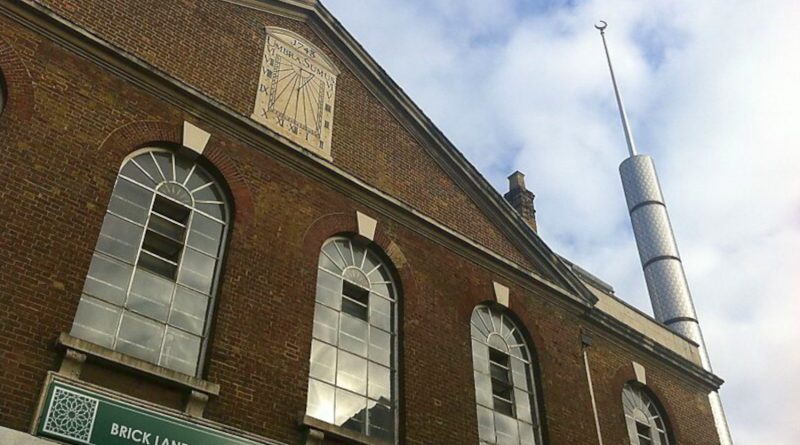The eternal message of Brick Lane Jamme Mosque’s sundial uniting Islam, Judaism and Christianity
From a Church, to a Synagogue and most recently a Mosque, the Brick Lane Jamme Masjid and its sundial have presided over the changing dominant faiths in the area but remained a steadfast reminder of the same prophetic message.
Having weaved through stall hawkers, anorak clad tourists, suited spillover from the city and men in kufis sunning their faces after communal prayer, you may release a sigh of relief as you turn off Brick Lane onto the relative quiet of Fournier Street.
The Brick Jamme Masjid straddles the two streets, and its towering steel minaret ceremoniously marks their intersection. It contrasts quite brilliantly with the surrounding building’s symmetrical and classical Georgian architecture.
The whole street is in fact alive with a mosaic of symmetries and contrasts, a Union Jack flag above one door, remnants of Jewish signage above others, and Indian and Bengali restaurant names displayed, italicized and bold.
Now crane your head towards the sky of minaret points, Church steeples and brick chimneys and you will see the Mosque’s sundial, mounted up high. Against the darker bricks, the sundial’s stone gleams and its etchings are clearly legible, both with the date 1743 and the words ‘Umbra Sumus’ beneath. The effect is calming, belying the bustle of this landmark’s historic underbelly.
This latin phrase cryptically translates to ‘We Are Shadows’, which hints of the sundial’s primary purpose of telling the time by tracking the sun, as well as a whole dearth of referential meanings.
The words are from the Ode to Horace (4.7), and the main stanza in question translates as:
The moons, however, quickly repair their heavenly losses; when we have fallen to where Father Aeneas fell, and wealthy Tullus and Ancus, we are dust and shadow.
The ode describes the changing seasons and constant rise and fall of the moon in a promise of rebirth. Despite this meager consolation, it also warns us mere mortals that our time on earth is fleeting…
This rather sombre message has just as much relevance in 1743 as it does today, but to understand it in its entirety, we must rewind the clock.
La Neuve Eglise: The Huguenots
The sundial first adorned the exterior of the La Neuve Eglise (The New Church), both of which were built by the French réfugiés of Bethnal Green. Escaping religious persecution in France, 40,000 to 50,000 Huguenots fled to London entering through the docklands, landing in Spitalfields as their place of sanctuary.
The Huguenots were othered by their fellow Londoners, but in true Horatian style they managed to forge their way through the city’s shadows and smog with thanks to their artisanal abilities. As weavers and merchants they revived the country’s silk industry, first introduced by James I, which is a history closely tied to Bethnal Green’s beloved Mulberry Tree.
With time and hard graft, the French assimilated to the nation’s idea of acceptability, and so they eventually moved out of the poverty of Spitalfields and into the suburbs.
However, the surrounding area’s industrial textile landscape and its diverse demographic shows us that the Huguenots’ legacy is not merely one of their plight, but of their enduring cultural and economic imprint.
Walking through the streets of Spitalfields, you can’t miss the saree shop fronts and old textile factory signs, clues of the ways in which history was set on its course.
The sundial’s meaning reached further than perhaps the Huguenots could have imagined. They could never have known that they pioneered the way for many more refugees and migrants to come.
The Great Synagogue
Next the Jewish refugees, escaping pogroms and violent expulsions from the Russian empire made a home in the East End. And so, the sundial was adopted by the Machzike Hadath in 1891 when it became known as the Great Synagogue, serving the community for over seventy years.
However, the Jewish community suffered discrimination anew, despite their escape from persecution and destitution back home. This manifested in heavy policing of the area, which became ‘ghettoised’, as well as the normalisation of prejudice and exclusion.
The sundial’s dual prognosis of new beginnings and apocalyptic omens ran true and clear once again.
The Great Mosque: Banglatown
In the area’s most recent migratory moment are the Sylheti seamen from East Bengal, who having worked on British merchant navy ships sought sanctuary in the shadows of Spitalfield. This followed the violent break-up of the Indian subcontinent and consequential creation of Bangladesh in the mid-twentieth century.
In 1976, the Synagogue and the sundial underwent their next transformation. Having been bought by donations from the Sylheti community, the London Jamme Masjid, or the Great Mosque, was born.
Even though it would be impossible to separate Spitalfields from it’s Bangladeshi culture in today’s popular imagination (particularly cherished for its Brick Lane curry houses), the community has not escaped the shadows the sundial ominously casts.
We need look no further than the 1978 riots following the racist murder of Altab Ali, nor the fact that the council still fits flats with fire-proof letter boxes to prevent arson attacks on Bangladeshi homes.
With recent plans to redevelop the Truman Brewery, we can likely expect changes on the horizon once again, despite significant resistance. If you listen carefully, you may be able to distinguish the words ‘Allahu akbar’ in the call to prayer from the background hum of building works as regeneration unfolds in all surrounding directions.
Brick Lane’s chameleon-like sundial tells tales of dissent, riotous spirit and the blood, sweat and tears of it’s generations of labourers. But it also tells us of humanity’s goodness, of its capacity to open its arms to those in need and subsequently, the tale of migration that is in fact as old as time.
The sundial is a steadfast reminder that the routes and roots of British citizenship have long been richly diverse and ever evolving. From this we could perhaps hope to embrace the eventuality of the changing seasons and moons, and in doing so even learn to unpick the historical divides made between belonging and other; of native and not; and to esteem what came before us.
If you enjoyed reading this, you may enjoy our photo trail of Bethnal Green’s Mulberry Tree.


